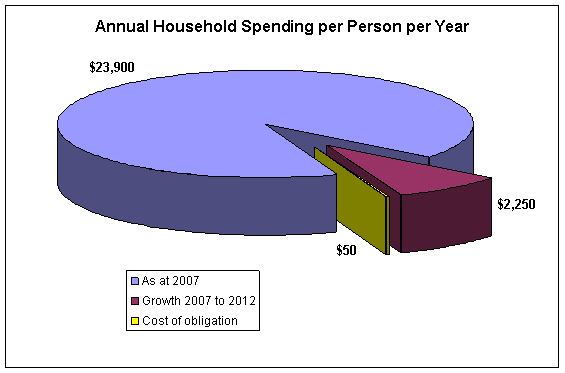What will the emissions trading scheme cost?
What Will the Emissions Trading Scheme Cost?
As speculated some weeks ago, the government has decided to introduce a price on carbon emissions in the form of an emissions trading system (ETS), rather than via a carbon tax. Whilst involving higher transactions costs than a tax, especially with some industries receiving free allocations of emission rights (the right to emit greenhouse gases for free), the ETS does at least involve all industries in the economy – eventually. Forestry enters the scheme in 2008, liquid fossil fuels in 2009, stationary energy and industrial processes in 2010, and agriculture in 2013, although industries may well begin reducing emissions voluntarily before their entry dates. All industries except for electricity generation and liquid fuels receive generous free allocations.
Various commentators have stated that even with the phased entry and free allocations, the cost to the economy will be substantial. They are wrong. There are two fundamental issues to be considered in understanding the costs of the ETS:
- The size of the 'shock’ to the economy.
- The difference between the cost to the nation and the cost to particular parties.
Firstly, the size of the shock. Over the period 2008-2012 the ETS will apply only to carbon dioxide, annual emissions of which are likely to be around 40 mega tonnes. The future price of carbon is unknown, but many estimates are around $20/tonne. At this price the value of emissions is about $800 million. New Zealand’s gross domestic product is over $160 billion. Thus the proportion of GDP accounted for by the value of emissions is less than 0.5%. But this portion of GDP does not just disappear. Certainly some industries are worse off, but others are better off, which brings us to the second issue.
A price on emissions will raise the cost of energy and energy-intensive goods and services such as concrete and travel. That is the intention. Higher prices discourage the use of such goods and encourage the purchase of alternative fuels and investment in new manufacturing processes that produce fewer emissions. I may spend less on heating my home when gas prices rise, but I may decide to invest in more insulation instead, or in amore efficient heating system – options which become more economic under the ETS.
The gas industry will employ fewer people than it would have without a price on carbon emissions, but the manufacturers and installers of insulation will be looking for more staff. Of course there are transition costs – people cannot quickly move from one line of employment to another. The phase-in period helps to reduce these costs. More importantly though, the projected price on emissions is not high enough, especially coupled with the free allocation, to force large numbers of people and capital resources into unemployment. What will happen is that new jobs and new investment will be directed into different types of activities than would have been the case without a price on carbon emissions.
Thus while some businesses grow more slowly than they would have, others expand faster. Private costs in one area are largely offset by private benefits in another area. Our analysis, using a model of the entire economy, indicates that total real household spending by 2012 will be only 0.2% lower, or only about a quarter of the initial shock to the economy. To put this into more meaningful terms, between now and 2012 household spending is expected to increase from $23,900 per capita per year to around $26,200. The ETS will have the effect of reducing this to $26,150; not a large cost to meet our international obligations.
This $50 is the net effect on the standard of living of the increases in the prices of energy and energy- intensive goods. Ideally the cost of other goods and services would fall in price or, more realistically with inflation at 2% per annum, not increase as rapidly. So why is the total effect not neutral such that in 2012 prices are on average the same as they would have been without the ETS, with only relative prices changing?

The reason is that the $50 per person per year is not primarily attributable to the domestic price on carbon emissions. The prime determinant is the high probability that New Zealand will have to buy emission rights on the world market to cover our emissions in excess of what we are permitted under Kyoto.
Emissions permits cost real resources. Purchasing permits from offshore is like giving away some of our exports, meaning that households incur a loss in spending power. The more we can reduce this burden, the smaller the reduction in our national welfare. And therein lies the main reason for the introduction of the ETS – or any other mechanism that places a price on carbon emissions. A price on emissions leads to a decline emissions, but also reduces the exports that we have to give away. That ensures we meet our Kyoto obligations at lower national cost.
Without a policy that puts a price on carbon emissions it is likely that New Zealand would have to buy more emission rights offshore, thereby increasing the national cost of meeting our Kyoto obligation as we would have to give away more exports.
The ETS as announced has the correct general design parameters, albeit that issues such as the implementation details, permit price volatility, and the undesirable possibility of long term free allocation for selected industries have yet to be resolved. Nevertheless the ETS is better than many alternatives emission reduction schemes.






